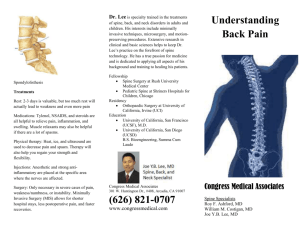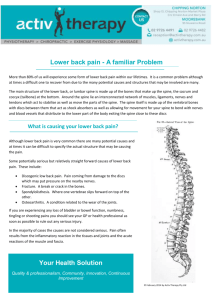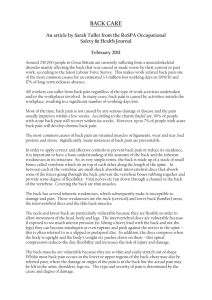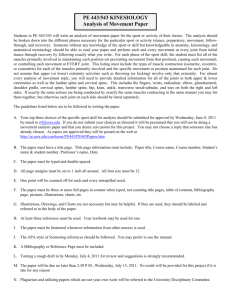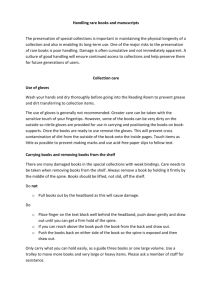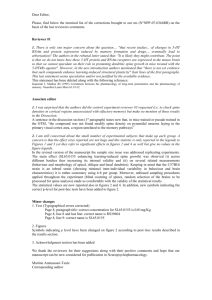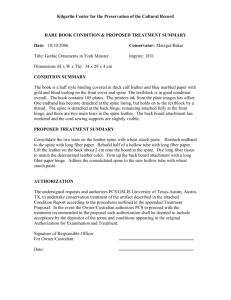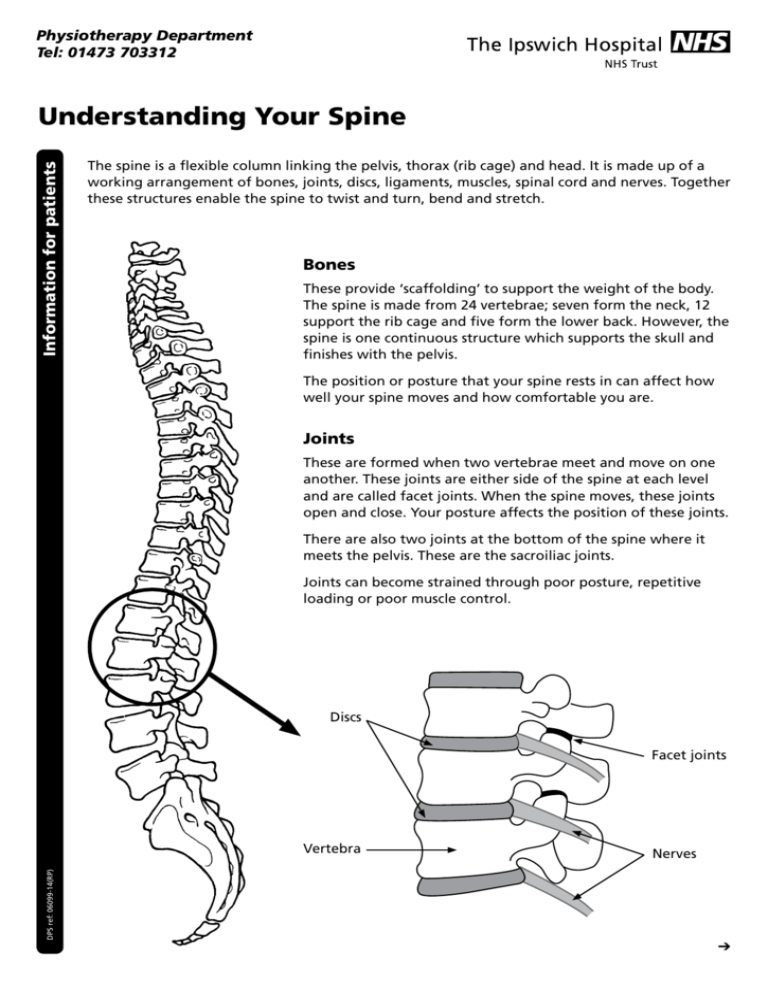
Physiotherapy Department
Tel: 01473 703312
Information for patients
Understanding Your Spine
The spine is a flexible column linking the pelvis, thorax (rib cage) and head. It is made up of a
working arrangement of bones, joints, discs, ligaments, muscles, spinal cord and nerves. Together
these structures enable the spine to twist and turn, bend and stretch.
Bones
These provide ‘scaffolding’ to support the weight of the body.
The spine is made from 24 vertebrae; seven form the neck, 12
support the rib cage and five form the lower back. However, the
spine is one continuous structure which supports the skull and
finishes with the pelvis.
The position or posture that your spine rests in can affect how
well your spine moves and how comfortable you are.
Joints
These are formed when two vertebrae meet and move on one
another. These joints are either side of the spine at each level
and are called facet joints. When the spine moves, these joints
open and close. Your posture affects the position of these joints.
There are also two joints at the bottom of the spine where it
meets the pelvis. These are the sacroiliac joints.
Joints can become strained through poor posture, repetitive
loading or poor muscle control.
Discs
Facet joints
DPS ref: 06099-14(RP)
Vertebra
Nerves
Ô
Discs
These separate the vertebrae and are located between each vertebra. Each disc is made up of a gel‑like
centre which is surrounded by rings of strong cartilage. The discs act as shock absorbers and allow
movement between the vertebrae. Discs can bulge or become torn under excessive, prolonged or
repetitive pressure.
Ligaments
These support the bones and joints. They help to stabilise the spine and prevent excess movement.
Ligaments can become strained through poor posture or repetitive loading.
Muscles
These create movement at the spine. They also play a very important role in stabilising the spine.
Muscles affecting the spine can be large powerful muscles affecting several joints or much smaller
muscles affecting one joint. They can extend from the skull down to the pelvis. Muscles can be torn
through injury, go into spasm (as a reaction to pain) or be inhibited (prevented from working properly,
either due to pain, weakness or poor posture).
Nerves
Between each pair of vertebrae there is a small opening for a nerve. The nerve carries messages to and
from the brain and other parts of the body via the spinal cord.
The nerves supply our muscles with power and our skin with sensation, such as feeling temperature,
pressure and pain. Nerves can become inflamed or pinched. This may cause a feeling of pain, pins and
needles or numbness. It can also cause a muscle to become weak. If this occurs in the lower back, this
may be felt in the buttock, hips or legs. In the neck this may be felt in the shoulders or arms. In the spine
nearest the rib cage this may be felt in the arms or around the rib cage.
If one or more of the above structures is injured or strained the body’s natural response is to become
inflamed. In the majority of cases the body will heal itself and any pain or discomfort will resolve.
Occasionally the body reacts differently to the injury or strain, which can lead to chronic pain.
Sometimes the cause of the problem is obvious, if you have had an accident for example. Often the
cause is less clear and is a combination of events over weeks, months, or even years.
Posture is often at fault. The way we sit at home, at work or when driving, the way we stand, walk or
even lie, can put excessive strain on the spine. This can be because of poor habits learnt over a lifetime,
badly designed furniture, or muscles not supporting the spine properly.
Some activities and movements can put your back at risk. Many factors can place strain on the back and
lead to injury, including being in a poor working position, repetitive movements, or if you are not strong
or flexible enough for the task.
In order to ensure good recovery and prevent a recurrence of the problem, it is important that you know
how to look after your back and how to reduce the risk of injury. Your physiotherapist will discuss this
with you during your physiotherapy session.
Produced by:
The Ipswich Hospital NHS Trust
Heath Road, Ipswich, Suffolk IP4 5PD
Hospital switchboard: 01473 712233
www.ipswichhospital.nhs.uk
Issue 3: January 2015 Review date: December 2017
© The Ipswich Hospital NHS Trust, 2007-2015. All rights reserved. Not to be
reproduced in whole, or in part, without the permission of the copyright owner.

